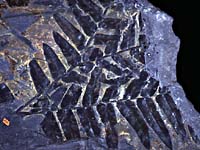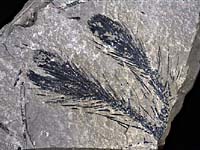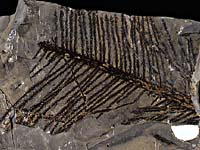







The beginning of the Carboniferous generally had a more uniform, tropical, and humid climate throughout the year than exists today. Seasons if any were indistinct. These observations are based on comparing the morphology of the plants that exist in the fossil record with plants that are present today. The morphology of the Carboniferous plants resembles the plants that live in tropical and mildly temperate areas today. Many of them lack growth rings, suggesting a uniform climate. This uniformity in climate may have been the result of the large expanse of ocean that covered the entire surface of the globe except for a small, localized section where Pangea, the massive supercontinent that existed during the late Paleozoic and early Triassic, was forming during the Carboniferous.
Shallow, warm, marine waters often flooded the continents. Attached filter feeders such as bryozoans, particularly fenestellids, were abundant in this environment, and the sea floor was dominated by brachiopods. Trilobites were increasingly scarce while foraminifers were abundant. The heavily armored fish from the Devonian became extinct, being replaced with fish fauna that look more modern.
 |
 |
Out with the old : Though many spectacular plant forms dominated the Carboniferous, most of them disappeared before the end of the Paleozoic. On the left, Neuropteris, a leaf form associated with the Medullosan seed-ferns. These early seed plants had fern-like leaves. On the right, terminal branches from Lepidodendron sternbergii, one of the great scale trees, most of which went extinct at the Westphalian - Stephanian boundary in the Late Carboniferous.
Near the end of the Mississippian, uplift and erosion of the continents occurred, causing an increase in the number of floodplains and deltas present. The deltaic environment supports fewer corals, crinoids, blastoids, cryozoans, and bryzoans, which were abundant earlier in the Carboniferous. Freshwater clams first appear along with an increase in gastropod, bony fish, and shark diversity. At first glance, it may seem that the marine habitat has grown allowing the diversity of marine life to increase, but in actuality, the movement of the continents to form one large continental mass decreased the sea coast area.
The amount of space available for marine life declined, and the sea levels all over the world fluctuated because of the presence of two large ice sheets at the southern pole which suck up large amounts of water and lock it away from the water cycle as ice. Because so much water is taken out of the water cycle, the sea levels drop leading to the mass extinction of shallow marine invertebrates, the gradual decline of swamps, and the increase in terrestrial habitat. These effects are reversed when the glaciers start to recede, releasing the water that they had stored as ice back into the oceans, flooding the swamps again and the floodplains. Carboniferous rock formations often occur in patterns of stripes with shale and coal seams alternating, indicating the cyclic flooding and drying of an area.
 |
 |
In with the new : Many groups that appeared in the Carboniferous would give rise to groups that dominated the Permian and Mesozoic. On the left is Amphibiamus lyelli, an early temnospondyl. These amphibian-like early tetrapods grew to the size of crocodiles in the Permian and Triassic. On the right, Lebachia, an early relative of the conifers.
The uplift of the continents caused a transition to a more terrestrial environment during the Pennsylvanian period. Swamp forests as well as terrestrial habitats became common and widespread. In the swamp forests, the vegetation was marked by the numerous different groups that were present. Seedless plants such as lycopsids were extremely important in this community and are the primary source of carbon for the coal that is characteristic of the period. The lycopods underwent a major extinction event after a drying trend, most likely caused by the advance of glaciers, during the Westphalian-Stephanian boundary in the Pennsylvanian period. Ferns and sphenopsids became more important later during the Carboniferous, and the earliest relatives of the conifers appeared. The first land snails appeared, and insects with wings that can't fold back such as dragonflies and mayflies flourished and radiated. These insects, as well as millipedes, scorpions, and spiders became important in the ecosystem.
The trend towards aridity and an increase in terrestrial habitat lead to the increasing importance of the amniotic egg for reproduction. The earliest amniote fossil was the lizard-like Hylonomus, which was lightly built with deep, strong jaws and slender limbs. The basal tetrapods became more diverse during the Carboniferous. Fish-like bodies were replaced with large predators with long snouts, short sprawling limbs and flattened heads such as temnospondyls, like Amphibiamus shown above. Anthracosaurs (basal tetrapods and amniotes with deep skulls and a less sprawling body plan which led to increasing agility) appeared during the Carboniferous and were quickly followed by diapsids which divided into two groups: the marine reptiles, lizards, and snakes versus the archosaurs (crocodiles, dinosaurs, and birds). The synapsids also made their first appearance, and presumably the anapsids did as well, although the oldest fossils for that group are from the Lower Permian.
For more about life in the Carboniferous, visit the History of Paleozoic Forests page assembled by Hans Kerp. In addition to its own content, it links to images and information scattered across the web.
Find out more about the Carboniferous paleontology and geology of North America at the Paleontology Portal.


